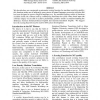Free Online Productivity Tools
i2Speak
i2Symbol
i2OCR
iTex2Img
iWeb2Print
iWeb2Shot
i2Type
iPdf2Split
iPdf2Merge
i2Bopomofo
i2Arabic
i2Style
i2Image
i2PDF
iLatex2Rtf
Sci2ools
COLING
2000
2000
Toward a Scoring Function for Quality-Driven Machine Translation
We describe how we constructed an automatic scoring function for machine translation quality; this function makes use of arbitrarily many pieces of natural language processing software that has been designed to process English language text. By machine-learning values of fnnctions available inside the software and by constructing functions that yield values based upon the software output, we are able to achieve preliminary, positive results in machine-learning the difference between human-produced English and machine-translation English. We suggest how the scoring ftmction may be used for MT system development.
Automatic Scoring Function | COLING 2000 | COLING 2008 | Language Processing Software | Machine-learning Values |
| Added | 01 Nov 2010 |
| Updated | 01 Nov 2010 |
| Type | Conference |
| Year | 2000 |
| Where | COLING |
| Authors | Douglas A. Jones, Gregory M. Rusk |
Comments (0)

